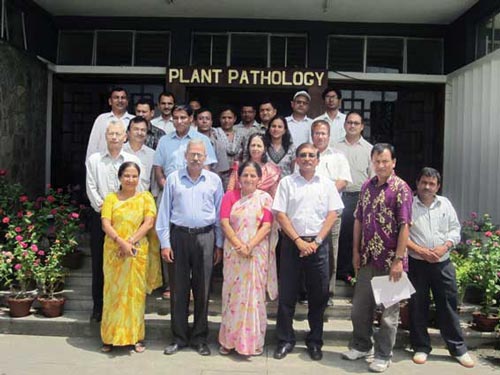From 2008-11 a Nepal Agricultural Research and Development Fund (NARDF)-funded project was conducted to try to minimize wheat losses caused by yellow rust in ten highly affected districts of Nepal, in partnership with the Department of Agriculture, CIMMYT (Nepal) and the Seed Quality Control Centre, Nepal. Following this project, a one-day interaction program organized by the Plant Pathology Division, CIMMYT (Nepal) and NARDF was held at the Nepal Agricultural Research Council (NARC), Khumaltar, Lalitpur on 14 July 2011. There were 52 participants, including members of NARDF, CIMMYT, Regional Agricultural Research Centers (Lumle), Agriculture Research Station (Dolaka and Pakhribas), National Wheat Research Program (NWRP) of NARC, and District Agricultural Development Officers of the ten affected districts.

In his opening address, chief of the Plant Pathology Division, Hirakaji Manandhar, thanked NARDF for funding the yellow rust project and CIMMYT (Nepal) for providing valuable support in terms of supplying new germplasm and organizing training, farmer’s field days, and this interaction program. Project coordinator Sarala Sharma went on to describe the achievements of the project, including the excellent performance of the CIMMYT varieties in the field. Farmers have been able to select seven rust-resistant wheat genotypes (BL2879, BL3235, BL3503, WK1182, WK1481, NL1064, and NL1073) within different domains and cropping systems of Nepal. The high-yielding genotypes NL1064 (Danphe) and NL1073 (Frankolin) also conveyed good resistance to the stem rust race Ug99, and high demand for the Danphe variety could lead to larger seed multiplication in the coming cycle.
Participants felt that the project enabled an increase in genetic diversity and wheat production through the introduction of improved varieties and effective control of yellow rust disease. Publications were distributed to farmers in order to increase awareness of the new varieties and 580 farmers received training in yellow and stem rust management and quality seed production. Subsequently, the farmers found that they obtained good prices for their seeds and farmer-farmer seed dissemination increased the coverage of resistant varieties.
The next step is to ensure promotion and uptake of the improved wheat varieties. Participants emphasized that because yellow rust is not only a regional problem, but a global one too, the new CIMMYT varieties should be integrated into the official release process by NWRP. Dhurba Bahadur Thapa, Sr. Wheat Breeder (NARC) promised to take action to assist this progression and Arun Kumar Joshi, Regional Wheat Breeder (CIMMYT) assured that CIMMYT will also continue varietal testing and seed multiplication with farmers in the ten districts, to aid sustainability of the project once NARDF funding ceases. Janaki Prasad Khanal, Member Secretary of NARDF said that he hoped projects such as this will help to make Nepal a food-secure country in the future.
 Capacity development
Capacity development 
